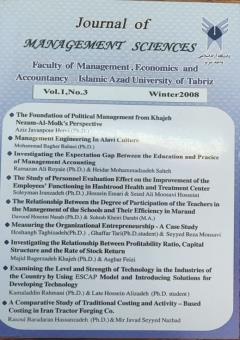Examining the Level and Strength of Technology in the Industries of the Country by Using ESCAP Model and Introducing Solutions for Developing Technology
Subject Areas : Business Management
Kamaledin Rahmani
1
,
Hossin Alizadeh
2
![]()
1 - Department of Management, Tabriz Branch, Islamic Azad University, Tabriz, Iran
2 - Ph.D. Student, Department of Industrial Management, Tabriz Branch, Islamic Azad University, Tabriz, Iran
Keywords: Technology, Level of technology, Strength of technology, the Models for examining the level and strength of technology,
Abstract :
The economic growth or asset of a country basically depends on the amount of goods which can be produced by the combination of land, capital, manpower and natural resources. Therefore , changing natural resources into production is the new process of economical development , and technology is the brain of this type of transformational activities. This tool not only makes the changing operation possible but also , in the world economy, makes the survival and growth foundation of business enterprises. The development of today’s technology has caused some changes in the productivity and costs, and because of this , the global and national structure in the areas of production, business and employment has been greatly affected. On this basis , according to the strategists of today’s world business, the most important strategic consideration in the international economic and industrial competition is succeeding in the field of technological and innovative management. Increasing the competitive advantages of any economical enterprise requires increased improvement in the strength of any type of technology which has been used in the production operation of that enterprise. This will happen by increasing the complexity of its technological elements and increasing the level of its technological strength (organizational learning). In this regard, analysing and examining the current situation and identifying the strong and weak points of the level and the strength of technology in the industry will be the starting point of any improvement and development in technology. The purpose of this article is to examine and evaluate the level and strength of industrial units in the country by presenting the conclusion of a comprehensive research work and identifying the strong and weak points of the technology of the industry in order to give some recommendations for the improvement and development of technology in industry.
Aghaei, H. M. (1990). Educational Technology Leaflet. Iranian Center for Self-Esteem Research and Services, (In Persian).
Asian and Pacific Center for Transfer of Technology Technology Atlas an Overview United Nations. (1998). Apctt Pab.
Chai, K. (1990). Technology in Less Developed Countries. Kist Press Seoul, 61-65.
Ernest B. (2000). Technology Background: Technology Assessment for Managers. Translated by: M., Zanjani, Tehran: Industrial Management Organization Publishing, (In Persian).
Floyd, Ch. (1997). Managing Technology for Corporate Success. Grow Hill Pab, 110-121.
Gris, F. (1998). Technology at the Service of the Firm. Translated by: Gh., Nasirzadeh, Tehran: Industrial Management Organization Publication, (In Persian).
Haj Fathali, A. (1993). Technology Development. Tehran: Allameh Tabatabai University Press, (In Persian).
Haj Fathali, A. (1993). Technology Development. Tehran: Allameh Tabatabai University Press, (In Persian).
Michael, E. P. (1985). Competitive Advantage. New York: Free Press. Sharif, N. (1988). Technology Transfer Management. Translated by: R., Aslani, Management and Planning Organization, (In Persian).
OECD. (1979). Science and Technology in the New Socio- Economic.
Sharif, N. (1988). Technology Transfer Management. Translated by: R., Aslani, Tehran: Management and Planning, (In Persian).
UNIDO. (1989). Technology Management in Developing Country. Global Vienna.
UNIDO. (1989). Industry and Develoment. Global Report.
Yusifpour, Gh. (1997). Technology Transfer in the Third World and Iran. Tehran: Tandis Publishing, (In Persian).
_||_
Aghaei, H. M. (1990). Educational Technology Leaflet. Iranian Center for Self-Esteem Research and Services, (In Persian).
Asian and Pacific Center for Transfer of Technology Technology Atlas an Overview United Nations. (1998). Apctt Pab.
Chai, K. (1990). Technology in Less Developed Countries. Kist Press Seoul, 61-65.
Ernest B. (2000). Technology Background: Technology Assessment for Managers. Translated by: M., Zanjani, Tehran: Industrial Management Organization Publishing, (In Persian).
Floyd, Ch. (1997). Managing Technology for Corporate Success. Grow Hill Pab, 110-121.
Gris, F. (1998). Technology at the Service of the Firm. Translated by: Gh., Nasirzadeh, Tehran: Industrial Management Organization Publication, (In Persian).
Haj Fathali, A. (1993). Technology Development. Tehran: Allameh Tabatabai University Press, (In Persian).
Haj Fathali, A. (1993). Technology Development. Tehran: Allameh Tabatabai University Press, (In Persian).
Michael, E. P. (1985). Competitive Advantage. New York: Free Press. Sharif, N. (1988). Technology Transfer Management. Translated by: R., Aslani, Management and Planning Organization, (In Persian).
OECD. (1979). Science and Technology in the New Socio- Economic.
Sharif, N. (1988). Technology Transfer Management. Translated by: R., Aslani, Tehran: Management and Planning, (In Persian).
UNIDO. (1989). Technology Management in Developing Country. Global Vienna.
UNIDO. (1989). Industry and Develoment. Global Report.
Yusifpour, Gh. (1997). Technology Transfer in the Third World and Iran. Tehran: Tandis Publishing, (In Persian).


